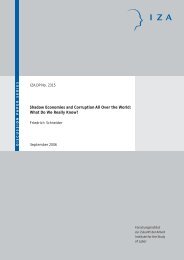Minimum Wages in Kenya Mabel Andalón - Index of - IZA
Minimum Wages in Kenya Mabel Andalón - Index of - IZA
Minimum Wages in Kenya Mabel Andalón - Index of - IZA
Create successful ePaper yourself
Turn your PDF publications into a flip-book with our unique Google optimized e-Paper software.
constant by virtue <strong>of</strong> multiply<strong>in</strong>g all m<strong>in</strong>imum wages by the same growth factor. 2<br />
Therefore, different m<strong>in</strong>imum wages across occupations have not contributed to modify<br />
relative wages across occupations or locations.<br />
In real terms, m<strong>in</strong>imum wages fell sharply from the period 1991 to 1994 and then<br />
<strong>in</strong>creased afterwards at a rate <strong>of</strong> 2 percent a year. However, <strong>in</strong> 2004 real wages had not<br />
recovered the 1991 level (Figure 1). In the last years (s<strong>in</strong>ce 1998) real m<strong>in</strong>imum wages<br />
have grown <strong>in</strong> l<strong>in</strong>e with real GDP per capita, but much below the growth rate <strong>of</strong> real<br />
wages <strong>in</strong> the private sector (Figure 1). The evolution <strong>of</strong> the real m<strong>in</strong>imum wage is almost<br />
identical if rather than a price <strong>in</strong>dex for the lower <strong>in</strong>come group, available only for<br />
Nairobi, an overall CPI <strong>in</strong>dex, obta<strong>in</strong>ed from the World Development Indicators (WDI) is<br />
used.<br />
The stabilization <strong>of</strong> <strong>in</strong>flation <strong>in</strong> 1995 brought real ga<strong>in</strong>s <strong>in</strong> m<strong>in</strong>imum and average wages.<br />
However, the relaxation <strong>of</strong> wage guidel<strong>in</strong>es <strong>in</strong> mid 1994 was followed by an upward<br />
adjustment <strong>of</strong> real wages <strong>in</strong> both the public and the private sector (Kulundu Manda,<br />
2002), which was not accompanied by similar adjustments <strong>in</strong> the m<strong>in</strong>imum wage. In<br />
fact, compared to the average wage, m<strong>in</strong>imum wages for general laborers decl<strong>in</strong>ed from<br />
0.35 <strong>of</strong> the average wage <strong>in</strong> the private sector <strong>in</strong> 1994, to 0.17 <strong>in</strong> 2004 (Figure 2). Given<br />
this evolution it is quite unlikely that m<strong>in</strong>imum wages are beh<strong>in</strong>d the sharp <strong>in</strong>crease <strong>in</strong><br />
average wages experienced s<strong>in</strong>ce 1994.<br />
III. Data<br />
In this study, we rely on aggregate data from the Central Bureau <strong>of</strong> Statistics (Economic<br />
Survey, various years) and micro-data from the 1998/99 Integrated Labour Force Survey<br />
(ILFS), a nationally representative survey conducted dur<strong>in</strong>g the months <strong>of</strong> December<br />
1998 and January 1999 to 11,040 households. At the <strong>in</strong>dividual level there are records for<br />
52,016 <strong>in</strong>dividuals. The ma<strong>in</strong> purpose <strong>of</strong> this survey was to gather <strong>in</strong>formation on the<br />
labor force, the <strong>in</strong>formal sector and child labor <strong>in</strong> <strong>Kenya</strong>.<br />
2 That is, with very few exceptions, the ratio <strong>of</strong> any m<strong>in</strong>imum wage to the average m<strong>in</strong>imum wage has been<br />
constant over the last years.<br />
6
















